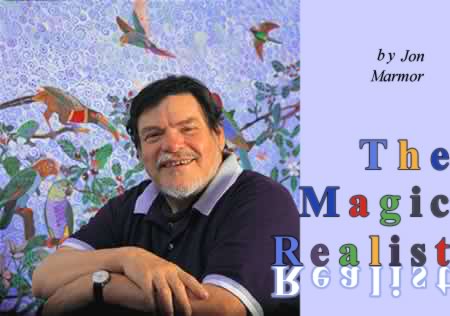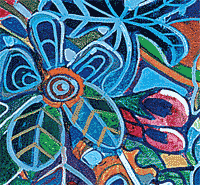
In Alfredo Arreguin's Life, Art Triumphed Over Adversity, Enabling Him to Become One of the Foremost Mexican-American Painters of His Generation.
Above, Alfredo Arreguin, considered the dean of Mexican-American artists in the Pacific Northwest, is seated in front of his work "Perico's Bay." Photographed June 26, 2001 at Linda Hodges Gallery in Seattle's Pioneer Square by Mary Levin.
The way Alfredo Arreguin slaps his knee and laughs his high-pitched laugh, you would never suspect all the abandonment, pain, heartbreak and discouragement he experienced as a child. Or how his unlikely journey from his native Mexico to the University of Washington 40 years ago helped put him on the road to becoming one of the greatest Hispanic artists of our time.
Arreguin's list of credits is staggering: his 1992 oil on canvas painting Sueno (Dream: Eve Before Adam) is in the permanent collection of the National Museum of American Art at the Smithsonian Institution. His paintings hang in the world's most prestigious galleries, he twice received fellowships from the National Endowment for the Arts, and he owns 19 national awards and prizes, many for his paintings on the environment.
He's likewise heralded for his community work, which ranges from donating works of art to non-profit organizations to teaching seriously ill patients at Seattle's Children's Hospital how to make forms from clay.

Detail from Arreguin's 2000 painting "Camilia #2." Photo by Mary Levin. Click the image to see a larger view of the complete work.
His success as an artist and the embrace from the community are certainly heartwarming, but what makes Arreguin glow is that he has a family of his own now: a loving wife, painter Susan Lytle, and 23-year-old daughter Lesley, a burgeoning artist in her own right (along with two grown children from a previous marriage). It's a huge change from the pain Arreguin grew up with, which started when his parents split when he was just a toddler. Raised by his grandparents until their deaths three days apart in 1948, he then bounced from living with his mother and stepfather to moving in with his father and stepmother when he turned 13. That last move came as quite a surprise, since Arreguin was told five years earlier that his father had died.
"It was the story of my life," Arreguin says, relaxing at his modest red brick home in North Seattle. "I have always been alone and not really part of a family. It was very devastating. When I later came to the U.S., I was a foreigner. And I wasn't part of Mexico, either. I didn't feel like I fit in anywhere."
The reunion with his dad, a prominent Mexico City businessman, was anything but warm. "I don't think he's my son, but I will help anyway," Arreguin recalls his father telling him. Soon after Arreguin's arrival in Mexico City, his father promptly sent him to a boarding school because they fought so often. Later, he got his son a construction job at a dam being built in the wild mountains of Guerrero state. The work was hard but being in the jungle made a lasting impression on Arreguin that would surface in his paintings years later.

He did not last long with his disapproving father, who considered his teenage son a troublemaker.
"My dad wanted to get rid of me," Arreguin recalls. "I was causing him trouble, I did poorly in school, and he wanted me out." So Arreguin's father gave him the money to start a business. Arreguin responded by blowing the windfall on a convertible and going to Acapulco to be a sometime tour guide.
There, he met a vacationing Danish family from Seattle, who befriended him and invited him to visit them in the Emerald City. During Arreguin's first trip to Seattle, they took him to the UW. He was wowed.
"What a great opportunity it was," he says. "I loved it." Here was his chance to get away from his father and start a new life.
- 'Fish Out of Water' Finds a Vision
- Hallucinatory Beauty Blooms From Painstaking Efforts
- Realist's Journey Leads to Reconciliation
- Return to September 2001 Table of Contents